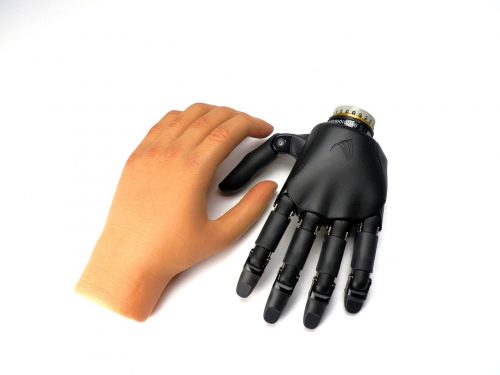Prostheses are artificial devices that are designed to replace missing limbs or parts of limbs and restore some of their capabilities. However, more than 30 percent of prostheses are abandoned by users because they fail to provide sensory feedback to the brain in a useful way.1 To address this issue, a multi-institutional team of researchers from Italy and Germany has developed a prosthetic hand that restores sensation to the amputee and approaches human capabilities to control the force applied when grasping an object and to sense object slippage.
Loredana Zollo, who coauthored the paper published in Science Robotics, says that the reason users usually abandon prostheses is that the devices often feel like a foreign body.2 To restore the complex sensing and manipulation capabilities of the human hand, information must be passed from the brain to the hand, and back to the brain. This back-and-forth communication between the brain and the hand allows the hand to sense and respond to changes in the environment.
The team of researchers from Italy and Germany were able to mimic such two-way communication between the brain and a prosthetic hand. By connecting electrodes to muscles in the upper arm or forearm of the user, the researchers enabled the brain to communicate the user’s intentions to the prosthetic hand. The electrodes capture electric signals that are generated when the user makes movements to control the hand. These signals are then decoded in a way that can be understood by the prosthetic device, which can then complete the intended action of the user.
However, getting the brain to transmit the user’s intention to the prosthesis is just half of the battle. The brain needs sensory information from the environment in order to signal to the hand to perform complex motion and to respond to changes in the environment. To achieve this, the team of researchers designed the prosthetic hand to generate a code that transmits the appropriate electrical impulses to the brain to provide the necessary sensory information, such as an object slipping.
The communication coded by the researchers is fast enough for the prosthesis to recognize patterns of object slippage, deliver the sensory information to the brain, receive a signal back from the brain indicating a certain “class” of gesture, and execute that class of gesture to catch the slipping object. According to the study, “the hand controller was able to acquire a new class of gesture from the classifier, including corrective actions due to slippages, about once every 100 milliseconds, which is comparable to the time observed with a natural human hand.” In other words, the entire process of decoding an intended gesture, controlling the hand, providing sensory feedback, and applying the corrective action took only about half a second. The team says their data strongly suggest that the reason for the increased capabilities of their prosthesis is its sensory feedback to the brain. The near-human capabilities of this prosthetic hand have the possibility to transform the way a person with missing limbs can interact with their environment.

